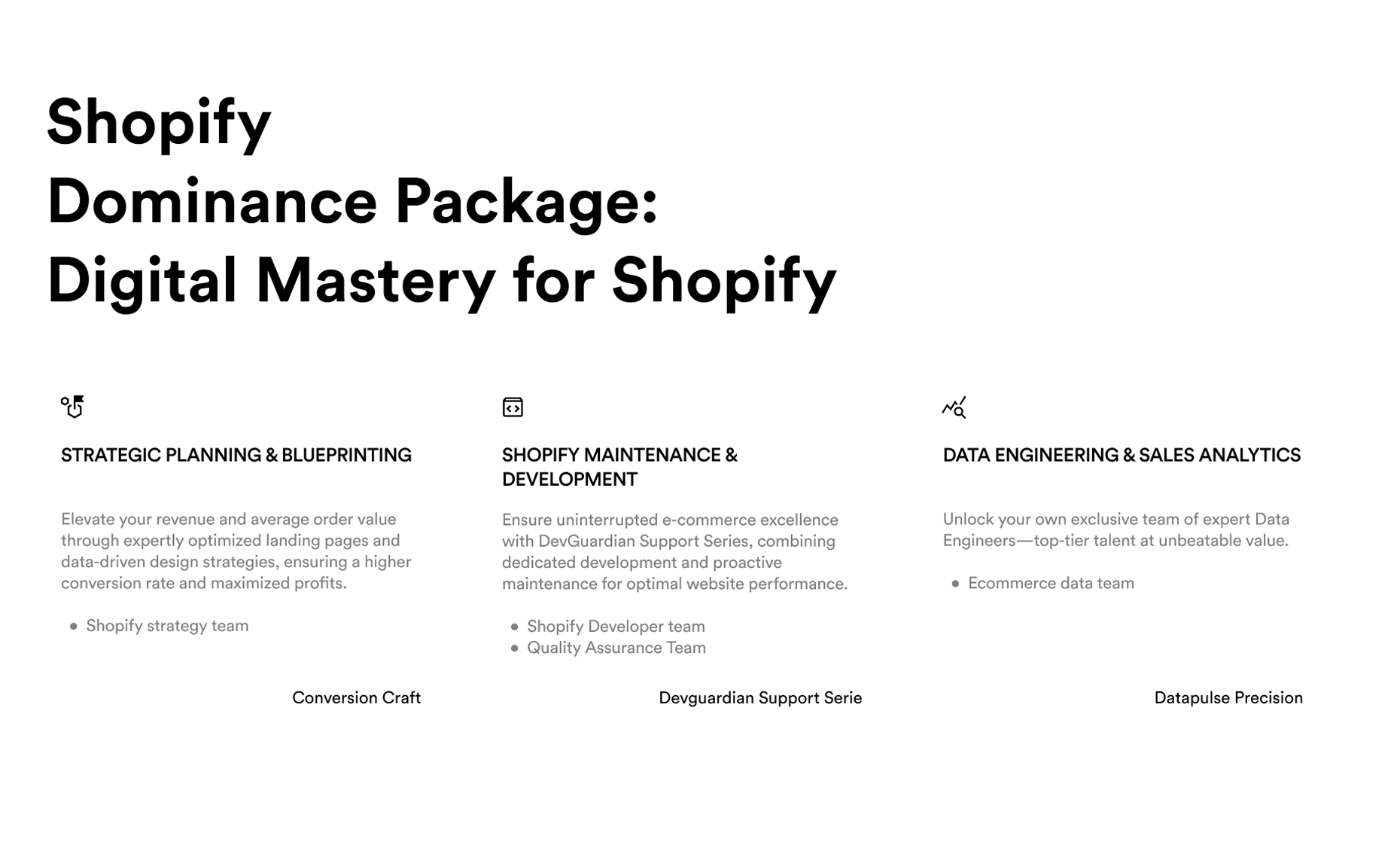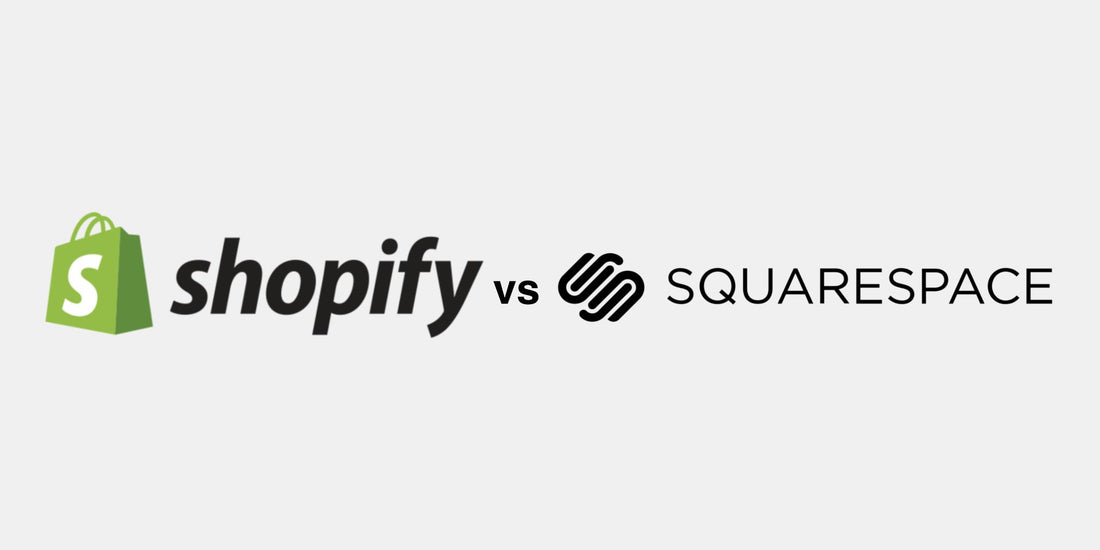Choosing the right platform for your online store can be a game-changer for your business. In e-commerce, two giants often face off: Squarespace and Shopify.
Each platform has its own strengths and weaknesses, making it crucial to understand them before committing.
In this article, we’ll dive deep into the ins and outs of Squarespace and Shopify, comparing features, pricing, ease of use, customer support, SEO capabilities, and more.
Understanding Squarespace and Shopify
Both Squarespace and Shopify have carved out their niches in the online market. Their structural differences make each platform suitable for different types of businesses.
But before we jump into the specifics, let's quickly break down what each platform has to offer.
What is Squarespace?

Squarespace is an all-in-one website building platform that emphasizes design and aesthetics. It’s ideal for artists, photographers, and small businesses seeking a visually stunning website without technical hassle. With sophisticated templates and a drag-and-drop interface, users can create a professional online presence quickly.
Branding and Analytics
One standout feature of Squarespace is its focus on branding, allowing users to create impressive portfolios. It integrates e-commerce capabilities seamlessly, primarily as an add-on.
Built-in analytics help track visitor data, providing invaluable insights for refining offerings and engaging customers.
Marketing Tools
Squarespace offers a range of marketing tools, including email campaigns and social media integration, to promote work effectively. Its SEO features help improve visibility on search engines, crucial for attracting new clients.
The platform ensures that even those with minimal technical skills can create a functional website.
What is Shopify?

Shopify is designed specifically for e-commerce, enabling businesses to sell products online easily. With built-in tools and extensive app integrations, it caters to both small startups and large enterprises.
Inventory and Sales Channels
Shopify's robust inventory management, payment processing, and shipping options make it the go-to choice for e-commerce merchants. It supports multiple sales channels, allowing sales on social media and in-person through Shopify POS systems.
Security and App Marketplace
Shopify emphasizes security with features like SSL certification and PCI compliance. Its extensive app marketplace enhances store functionality, making it a robust choice for scaling online businesses.
Key Features of Squarespace and Shopify
When it comes down to it, the features available on each platform can make or break your decision. Here's a closer look at what each platform brings to the table.
Squarespace's Unique Features
- Beautiful Templates: Squarespace offers stunning, design-focused templates that are easily customizable.
- Integrated Blogging: Squarespace has robust blogging features, making it ideal for content creators.
- Visual Analytics: The built-in analytics are presented in beautiful formats, helping you track performance intuitively.
These features contribute to Squarespace's appeal among creatives and visually-driven businesses. They understand that the first impression matters, and Squarespace helps you create that effortlessly.
Additionally, the platform's seamless integration with various social media channels allows users to showcase their work and engage with their audience directly, enhancing the overall user experience.
The ease of use is another significant advantage, as even those with minimal technical skills can navigate the interface and set up a professional-looking website in no time.
Shopify's Unique Features
Shopify’s features are built to facilitate not only selling but scaling your e-commerce business over time. It's about growth, and Shopify provides the tools to help you achieve that vision.
- Extensive App Ecosystem: Shopify supports a wide variety of third-party apps that enhance functionality.
- Multi-Channel Selling: You can sell on social media platforms and marketplaces easily.
- Powerful Analytics: Advanced analytics for tracking sales, conversion rates, and customer behaviors.
The platform also offers a range of payment gateways, allowing merchants to choose the most convenient options for their customers, which can significantly boost conversion rates.
Furthermore, Shopify’s customer support is renowned for its responsiveness and effectiveness, ensuring that users can resolve issues quickly and keep their businesses running smoothly.
Pricing Comparison: Squarespace vs Shopify
Your budget is a critical aspect of your decision-making process. Both Squarespace and Shopify offer different pricing tiers, and the choices can influence the overall cost of maintaining your online store.
Squarespace Pricing Plans

Squarespace's pricing structure is straightforward, but e-commerce features are only available at higher tiers, which may deter some budget-conscious startups.
However, the platform excels in design flexibility and user experience, making it a popular choice for creatives and small businesses that prioritize aesthetics.
- Personal Plan: Ideal for personal projects, starting at around $16/month.
- Business Plan: Offers e-commerce functionalities at about $23/month.
- Basic Commerce Plan: Advanced e-commerce features, roughly $28/month.
- Advanced Commerce Plan: Best for larger businesses, approximately $52/month.
Shopify Pricing Plans

While Shopify might appear more expensive upfront, the extensive features and tools you get at each pricing level often justify the cost. You'll be investing in a platform made for selling, which can be essential for your business growth.
- Basic Plan: Great for newcomers, starting around $19/month.
- Shopify Plan: The average plan at about $49/month, including advanced reporting.
- Advanced Plan: For serious sellers, costing around $299/month.
Ease of Use: Squarespace vs Shopify
Next up, let’s examine how easy it is to use these platforms. Clarity, simplicity, and efficiency in management can save you tons of time and reduce frustration.
User Interface of Squarespace
The Squarespace interface is visually appealing and intuitive. Drag-and-drop functionality makes it simple for anyone, regardless of technical skill, to design their site. Plus, the templates come with preset sections that you can easily fill in.
However, some users may find the learning curve a little steep when it comes to navigating all the features, particularly for e-commerce. Still, once you get the hang of it, the site management radiates ease of use.
Squarespace also offers a robust help center and community forums, which can be invaluable for troubleshooting and learning best practices.
The platform's built-in SEO tools are another plus, allowing users to optimize their content without needing extensive technical knowledge. This combination of user-friendly design and helpful resources makes Squarespace an appealing choice for those who prioritize aesthetics alongside functionality.
User Interface of Shopify
Shopify’s UI is also user-friendly but leans more towards functionality than aesthetics. It targets users who are focused on selling and scaling, so the dashboard is packed with data and tools that may initially seem overwhelming.
Shopify’s strong e-commerce focus, however, pays off for dedicated business owners looking to dive deep into analytics and sales strategy. The learning curve is there, but the payoff in understanding your business’s metrics is worth it.
Additionally, Shopify provides a variety of apps and integrations that can enhance the user experience, allowing for a tailored approach to online selling.
From inventory management to marketing automation, these tools can significantly streamline operations. Moreover, Shopify's extensive documentation and customer support options ensure that help is readily available, making it easier for users to navigate the complexities of running an online store efficiently.
Customization Options in Squarespace and Shopify
Customization can set your brand apart from the crowd, so let’s take a look at what these two platforms can do.
Design Flexibility in Squarespace
Squarespace offers beautiful templates that are customizable but can feel a bit restrictive. You can change colors, fonts, and images easily. However, if you want to go deeper, you might run into limitations unless you know how to code.
This design-oriented approach serves most creative professionals well, but traditional retailers may crave more flexibility in layout and product display. Squarespace's focus on aesthetics means that while you can create stunning visuals, the structural changes can be less intuitive.
For instance, if you want to create a unique grid layout for your products or implement a custom navigation structure, you might find yourself limited by the platform's predefined settings. This can be a double-edged sword; while it ensures a cohesive look, it can also stifle creativity for those who wish to break away from conventional designs.
Moreover, Squarespace's built-in tools for blogging and portfolio showcases are robust, making it an excellent choice for artists, photographers, and writers. The integration of social media feeds and email marketing tools further enhances its appeal for those looking to engage their audience.
However, for businesses focused solely on e-commerce, the platform may require additional workarounds to achieve a fully functional online store that meets all their needs.
Design Flexibility in Shopify
Shopify shines when it comes to functionality. With access to numerous apps, themes, and custom coding options, it allows businesses to create a unique online store tailored to their specific needs.
With Shopify, the sky's the limit. Whether you want to add new functionalities, integrate with other platforms, or modify the layout, you have a myriad of options to create that perfect e-commerce experience.
The platform supports a wide range of third-party apps that can enhance everything from inventory management to customer relationship management, enabling you to tailor your store to fit your operational requirements seamlessly.
Additionally, Shopify's theme store offers a diverse selection of both free and premium themes, catering to various industries and aesthetics. This means that whether you run a boutique clothing store or a tech gadget shop, you can find a theme that resonates with your brand's identity.
The ease of customizing these themes, along with the ability to edit the underlying code, empowers users to create a truly unique shopping experience. Furthermore, Shopify's commitment to mobile optimization ensures that your store looks great and functions well across all devices, a crucial factor in today's mobile-first shopping landscape.
SEO Capabilities: Squarespace vs Shopify
SEO is vital for driving organic traffic to your online store. Let’s explore the SEO tools available on each platform.
SEO Features in Squarespace
Squarespace comes equipped with built-in SEO tools. You can customize URLs, create meta titles, and use structured data markup to help search engines understand your content better.
However, while they do make it easy to set up essential SEO elements, some experienced users may find Squarespace lacking in advanced SEO customization options. For instance, the platform does not allow for extensive control over header tags or the ability to implement custom redirects easily.
This can be a drawback for users who are looking to optimize their site for specific keywords or manage large inventories, as they may need more granular control over their SEO settings.
Additionally, Squarespace's reliance on a single template system can limit the flexibility needed for advanced SEO strategies. While the design templates are visually appealing, they can sometimes restrict the implementation of certain SEO best practices, such as mobile optimization and page speed enhancements, which are crucial for ranking well in search engine results.
SEO Features in Shopify
Shopify has robust SEO features tailored specifically for e-commerce. It offers customizable title tags, meta descriptions, image alt text, and even integrates with various SEO apps to boost performance.
This focus ensures that as you build your store, you’re also creating a solid foundation for organic search visibility. If you're serious about driving traffic, Shopify often takes the lead.
Moreover, Shopify's platform is designed to handle large volumes of products and categories, making it easier to implement bulk editing for SEO elements, which is a significant advantage for larger online retailers.
Furthermore, Shopify provides built-in blogging capabilities, allowing you to create content that can enhance your SEO strategy. By regularly publishing relevant blog posts, you can attract more visitors to your site and improve your search rankings.
This content marketing aspect is crucial, as search engines favor fresh and relevant content, and Shopify makes it simple to integrate this into your overall SEO approach.
Choosing Between Squarespace and Shopify
As you weigh your options, it's essential to consider your specific needs. Each platform has its advantages and is designed for different types of users.
When to Choose Squarespace?
If your primary focus is on aesthetics, content, and branding—particularly if you’re an artist, photographer, or content creator—Squarespace might be the best match for you. It’s geared toward creating visually exceptional websites with a creative touch, making it perfect for showcasing products in a stunning way.
When to Choose Shopify?
If you’re an e-commerce business owner looking for robust features, inventory management, and sales optimization, Shopify should be your go-to choice. It's designed for those who prioritize selling and want a platform that can grow alongside their business. With Shopify, you’ll be in a well-equipped environment focused on driving sales and conversions.
Ultimately, the decision between Squarespace and Shopify comes down to your business goals and the type of experience you want to provide for your customers. Do your homework, consider your needs, and make the choice that sets you up for success in the ever-competitive online landscape.












